Report on Understanding Contemporary Organizations: BIZ102 Module
VerifiedAdded on 2023/03/23
|10
|2249
|72
Report
AI Summary
This report provides an analysis of contemporary organizations, focusing on the significance of self-awareness and emotional intelligence in the workplace. It explores strategies for effective interaction within diverse teams, highlighting the importance of communication and teamwork. The report includes a case study involving a team activity, detailing the strengths and weaknesses of team members and reflecting on the impact of emotional intelligence and self-awareness. Recommendations are provided to enhance teamwork and mutual understanding, emphasizing the allocation of roles, accountability, and continuous self-improvement. The report is designed to develop an understanding of how inter-cultural, diverse teams’ function and to help develop inter-cultural and diverse teams into high performing teams.
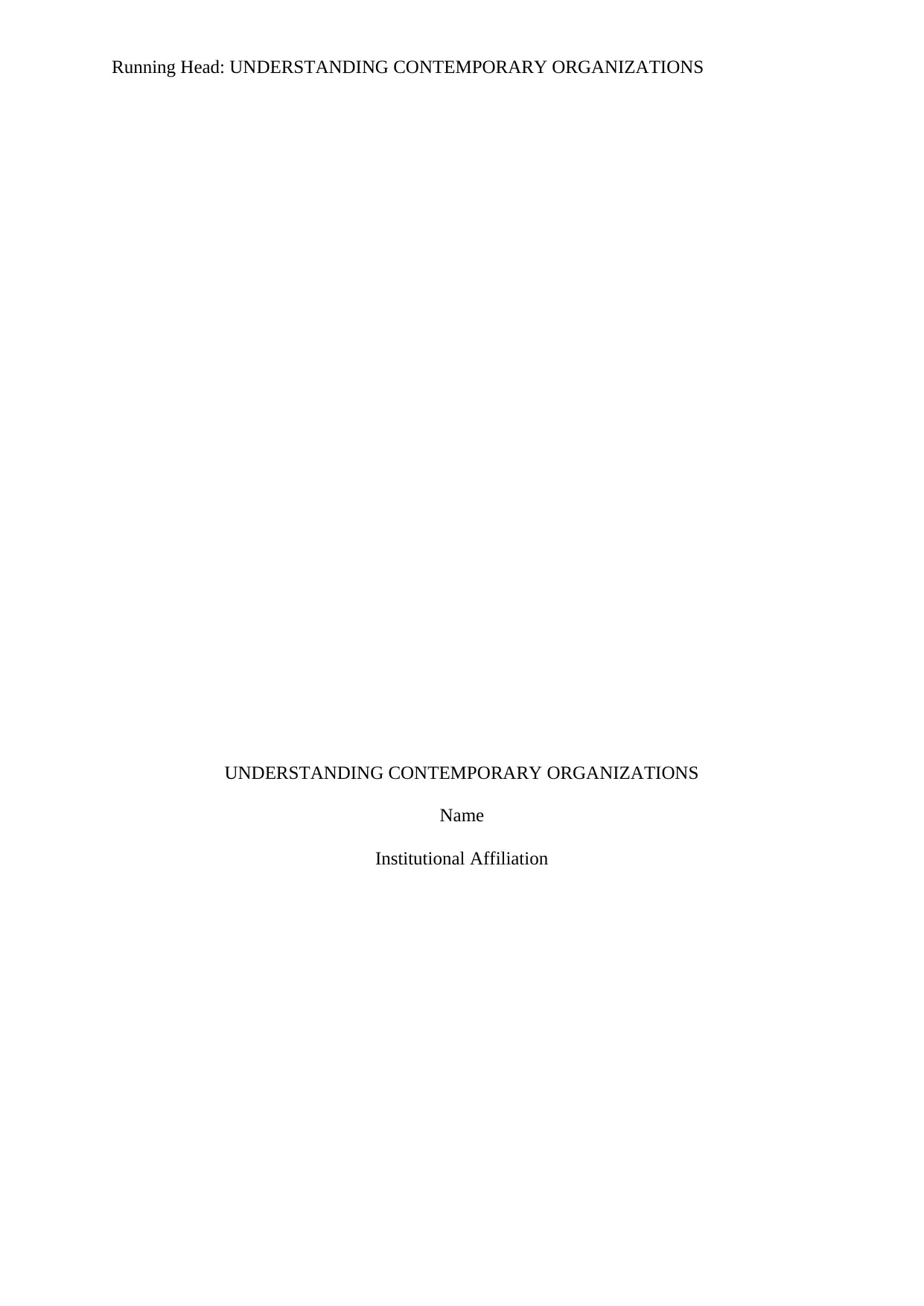
Running Head: UNDERSTANDING CONTEMPORARY ORGANIZATIONS
UNDERSTANDING CONTEMPORARY ORGANIZATIONS
Name
Institutional Affiliation
UNDERSTANDING CONTEMPORARY ORGANIZATIONS
Name
Institutional Affiliation
Paraphrase This Document
Need a fresh take? Get an instant paraphrase of this document with our AI Paraphraser
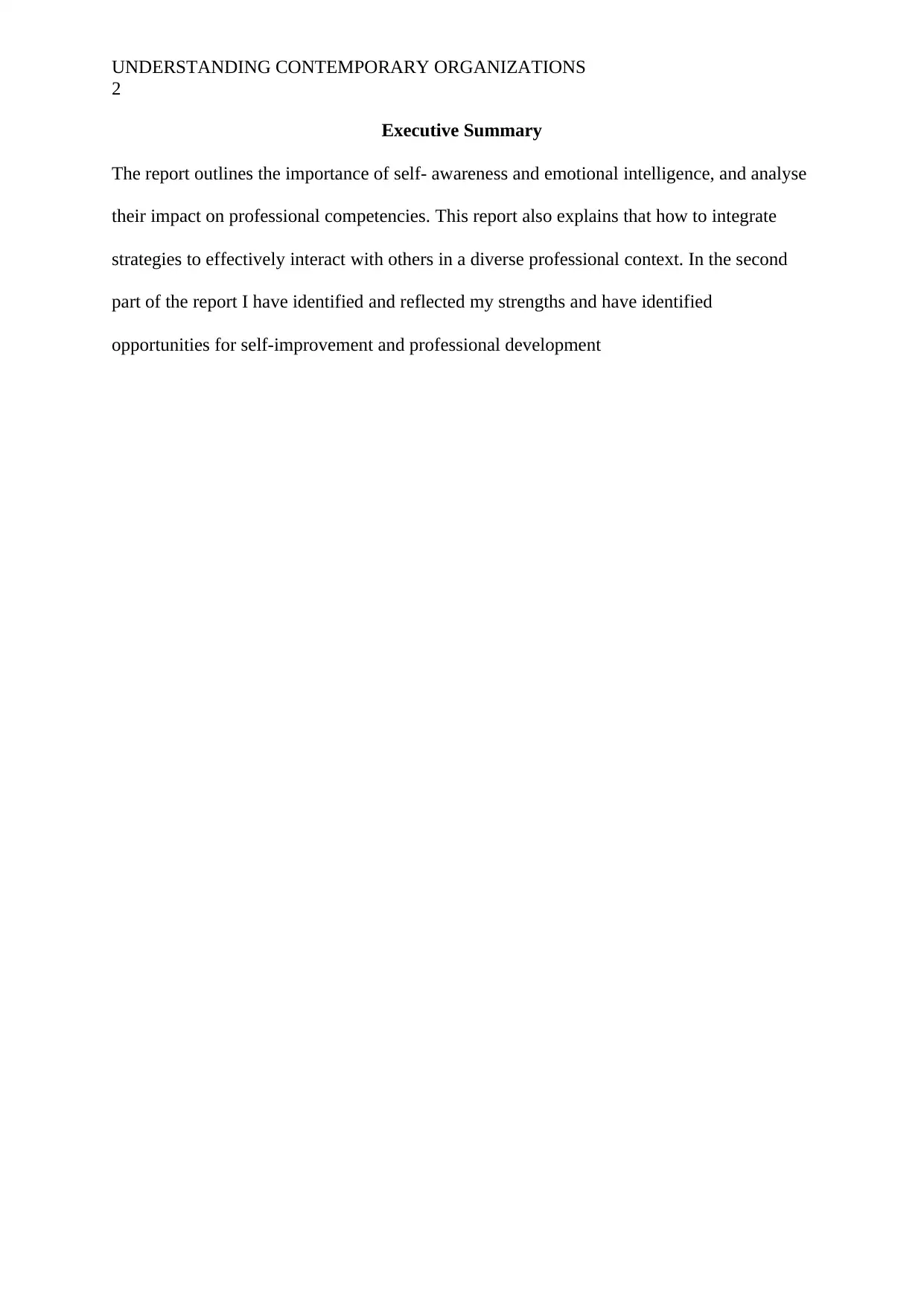
UNDERSTANDING CONTEMPORARY ORGANIZATIONS
2
Executive Summary
The report outlines the importance of self- awareness and emotional intelligence, and analyse
their impact on professional competencies. This report also explains that how to integrate
strategies to effectively interact with others in a diverse professional context. In the second
part of the report I have identified and reflected my strengths and have identified
opportunities for self-improvement and professional development
2
Executive Summary
The report outlines the importance of self- awareness and emotional intelligence, and analyse
their impact on professional competencies. This report also explains that how to integrate
strategies to effectively interact with others in a diverse professional context. In the second
part of the report I have identified and reflected my strengths and have identified
opportunities for self-improvement and professional development

UNDERSTANDING CONTEMPORARY ORGANIZATIONS
3
UNDERSTANDING CONTEMPORARY ORGANIZATIONS
INTRODUCTION
In the modern world, tremendous changes have occurred which have negated the validity
and prevalence of the old norms. Particularly at the workplace, homogeneity has disappeared,
and more and more diverse forms and shapes are arising. An important impetus behind the
commencement of this diverse and varied workforce is the element of globalisation which
has paved the way to more frequent cross-cultural interactions. Keeping these details in mind,
some personal traits and qualities have become more important than the others in the
workforce. These qualities when present in the team members ensure that the team is not only
productive and efficient but is also oriented towards its goals and objectives. These personal
qualities include self-awareness and emotional intelligence. Most of the discrepancies that
perpetuate on the workplace are not directly associated with the technicalities of the
workplace instead commence owing to shortcoming one or other personal qualities of the
workforce. For example, a team in which the human capital is not emotionally intelligence
will certainly let the biases, prejudices and other personal restriction prevail at the workplace.
This will lead to declined efficiency of the teamwork owing to lesser cooperation.
STRATEGIES FOR EFFECTIVE INTERACTION
Working effectively in a diverse team is quite a task. Some important strategies that
can be employed by the team members in order to interact and work effectively in a diverse
team yielding productivity and efficiency are detailed hereunder.
Organising Meetings
Organising meetings time to time is one of the best strategies to gear up the team
members from different cultural backgrounds. This enables the team members to hear the
mouth word of the leadership from the managers. This serves to keep the team members
rights on the track. Therefore, it avoids the continuation of any misguidance (Mathieu &
Rapp, 2018).
3
UNDERSTANDING CONTEMPORARY ORGANIZATIONS
INTRODUCTION
In the modern world, tremendous changes have occurred which have negated the validity
and prevalence of the old norms. Particularly at the workplace, homogeneity has disappeared,
and more and more diverse forms and shapes are arising. An important impetus behind the
commencement of this diverse and varied workforce is the element of globalisation which
has paved the way to more frequent cross-cultural interactions. Keeping these details in mind,
some personal traits and qualities have become more important than the others in the
workforce. These qualities when present in the team members ensure that the team is not only
productive and efficient but is also oriented towards its goals and objectives. These personal
qualities include self-awareness and emotional intelligence. Most of the discrepancies that
perpetuate on the workplace are not directly associated with the technicalities of the
workplace instead commence owing to shortcoming one or other personal qualities of the
workforce. For example, a team in which the human capital is not emotionally intelligence
will certainly let the biases, prejudices and other personal restriction prevail at the workplace.
This will lead to declined efficiency of the teamwork owing to lesser cooperation.
STRATEGIES FOR EFFECTIVE INTERACTION
Working effectively in a diverse team is quite a task. Some important strategies that
can be employed by the team members in order to interact and work effectively in a diverse
team yielding productivity and efficiency are detailed hereunder.
Organising Meetings
Organising meetings time to time is one of the best strategies to gear up the team
members from different cultural backgrounds. This enables the team members to hear the
mouth word of the leadership from the managers. This serves to keep the team members
rights on the track. Therefore, it avoids the continuation of any misguidance (Mathieu &
Rapp, 2018).
⊘ This is a preview!⊘
Do you want full access?
Subscribe today to unlock all pages.

Trusted by 1+ million students worldwide
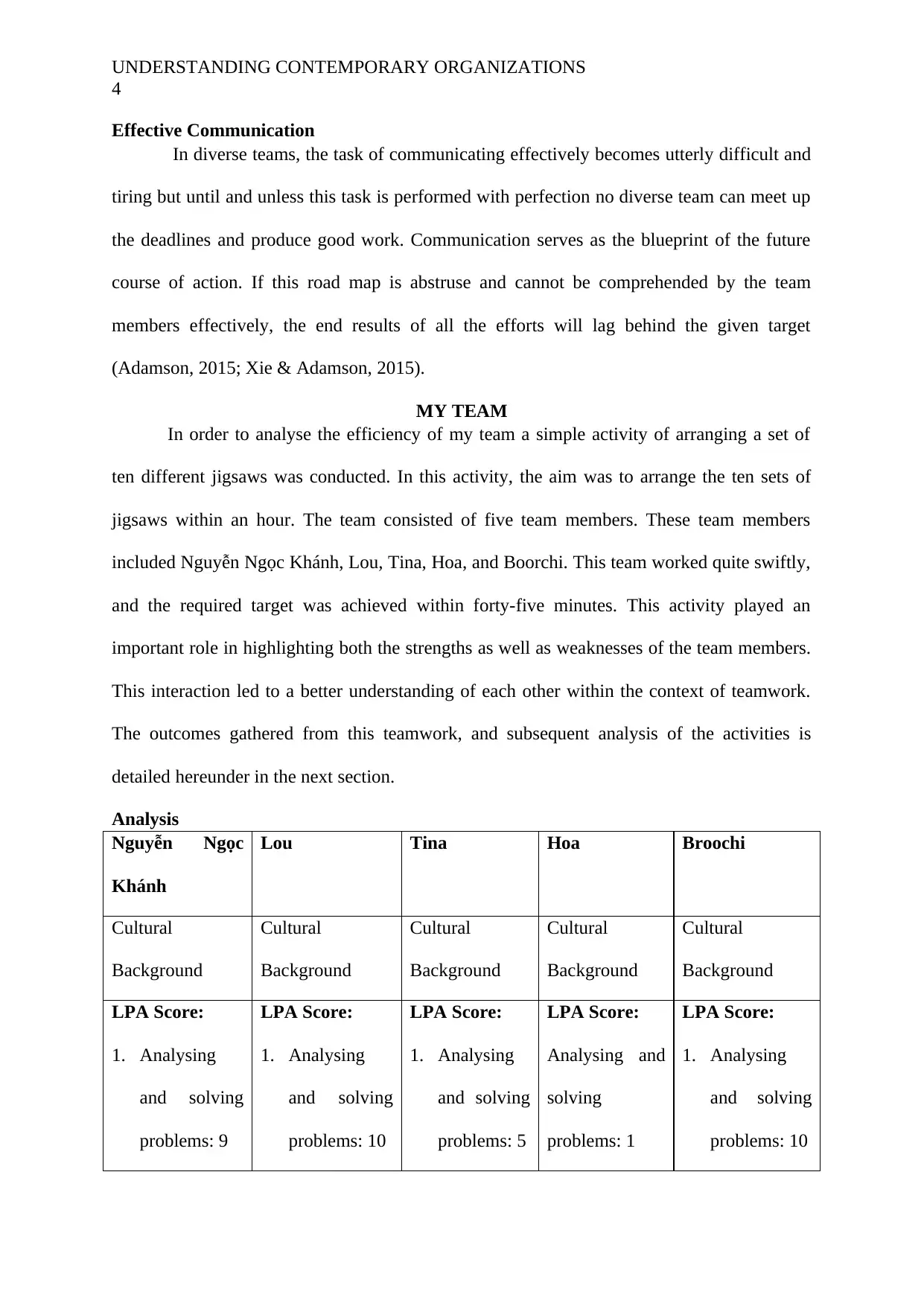
UNDERSTANDING CONTEMPORARY ORGANIZATIONS
4
Effective Communication
In diverse teams, the task of communicating effectively becomes utterly difficult and
tiring but until and unless this task is performed with perfection no diverse team can meet up
the deadlines and produce good work. Communication serves as the blueprint of the future
course of action. If this road map is abstruse and cannot be comprehended by the team
members effectively, the end results of all the efforts will lag behind the given target
(Adamson, 2015; Xie & Adamson, 2015).
MY TEAM
In order to analyse the efficiency of my team a simple activity of arranging a set of
ten different jigsaws was conducted. In this activity, the aim was to arrange the ten sets of
jigsaws within an hour. The team consisted of five team members. These team members
included Nguyễn Ngọc Khánh, Lou, Tina, Hoa, and Boorchi. This team worked quite swiftly,
and the required target was achieved within forty-five minutes. This activity played an
important role in highlighting both the strengths as well as weaknesses of the team members.
This interaction led to a better understanding of each other within the context of teamwork.
The outcomes gathered from this teamwork, and subsequent analysis of the activities is
detailed hereunder in the next section.
Analysis
Nguyễn Ngọc
Khánh
Lou Tina Hoa Broochi
Cultural
Background
Cultural
Background
Cultural
Background
Cultural
Background
Cultural
Background
LPA Score:
1. Analysing
and solving
problems: 9
LPA Score:
1. Analysing
and solving
problems: 10
LPA Score:
1. Analysing
and solving
problems: 5
LPA Score:
Analysing and
solving
problems: 1
LPA Score:
1. Analysing
and solving
problems: 10
4
Effective Communication
In diverse teams, the task of communicating effectively becomes utterly difficult and
tiring but until and unless this task is performed with perfection no diverse team can meet up
the deadlines and produce good work. Communication serves as the blueprint of the future
course of action. If this road map is abstruse and cannot be comprehended by the team
members effectively, the end results of all the efforts will lag behind the given target
(Adamson, 2015; Xie & Adamson, 2015).
MY TEAM
In order to analyse the efficiency of my team a simple activity of arranging a set of
ten different jigsaws was conducted. In this activity, the aim was to arrange the ten sets of
jigsaws within an hour. The team consisted of five team members. These team members
included Nguyễn Ngọc Khánh, Lou, Tina, Hoa, and Boorchi. This team worked quite swiftly,
and the required target was achieved within forty-five minutes. This activity played an
important role in highlighting both the strengths as well as weaknesses of the team members.
This interaction led to a better understanding of each other within the context of teamwork.
The outcomes gathered from this teamwork, and subsequent analysis of the activities is
detailed hereunder in the next section.
Analysis
Nguyễn Ngọc
Khánh
Lou Tina Hoa Broochi
Cultural
Background
Cultural
Background
Cultural
Background
Cultural
Background
Cultural
Background
LPA Score:
1. Analysing
and solving
problems: 9
LPA Score:
1. Analysing
and solving
problems: 10
LPA Score:
1. Analysing
and solving
problems: 5
LPA Score:
Analysing and
solving
problems: 1
LPA Score:
1. Analysing
and solving
problems: 10
Paraphrase This Document
Need a fresh take? Get an instant paraphrase of this document with our AI Paraphraser

UNDERSTANDING CONTEMPORARY ORGANIZATIONS
5
2. Working well
with others: 3
3. Achieving
objectives: 5
4. Learning and
self-
development:
4
5. Adapting to
change: 5
2. Working well
with others: 4
3. Achieving
objectives: 10
4. Learning and
self-
development:
8
5. Adapting to
change: 7
2. Working
well with
others: 2
3. Achieving
objectives:
5
4. Learning
and self-
developmen
t: 6
5. Adapting
the change:
9
Working well
with others: 1
Achieving
objectives: 0
Learning and
self-
development: 4
Adapting to
change: 2
2. Working
well with
others: 4
3. Achieving
objectives: 3
4. Learning and
self-
development:
2
5. Adapting to
change: 4
Clifton
Strengths:
1. Significance
2. Context
3. Strategic
4. Positivity
5.
Communication
Clifton
Strengths:
1. Achiever
2. Learner
3. Restorative
4. Positivity
5. Relator
Clifton
Strengths:
1. Includer
2. Restorative
3. Achiever
4. Consistency
5. Learner
Clifton
Strengths:
1. Includer
2. Self-
Assurance
3. Deliberative
4. Analytical
5. Restorative
Clifton
Strengths:
1. Command
2. Analytical
3. Significance
4. Focus
5. Strategic
El:
1. Self-awareness -
El:
1. Self-awareness:8
El:
Self-
El:
Self-
El:
Self-awareness:6
5
2. Working well
with others: 3
3. Achieving
objectives: 5
4. Learning and
self-
development:
4
5. Adapting to
change: 5
2. Working well
with others: 4
3. Achieving
objectives: 10
4. Learning and
self-
development:
8
5. Adapting to
change: 7
2. Working
well with
others: 2
3. Achieving
objectives:
5
4. Learning
and self-
developmen
t: 6
5. Adapting
the change:
9
Working well
with others: 1
Achieving
objectives: 0
Learning and
self-
development: 4
Adapting to
change: 2
2. Working
well with
others: 4
3. Achieving
objectives: 3
4. Learning and
self-
development:
2
5. Adapting to
change: 4
Clifton
Strengths:
1. Significance
2. Context
3. Strategic
4. Positivity
5.
Communication
Clifton
Strengths:
1. Achiever
2. Learner
3. Restorative
4. Positivity
5. Relator
Clifton
Strengths:
1. Includer
2. Restorative
3. Achiever
4. Consistency
5. Learner
Clifton
Strengths:
1. Includer
2. Self-
Assurance
3. Deliberative
4. Analytical
5. Restorative
Clifton
Strengths:
1. Command
2. Analytical
3. Significance
4. Focus
5. Strategic
El:
1. Self-awareness -
El:
1. Self-awareness:8
El:
Self-
El:
Self-
El:
Self-awareness:6
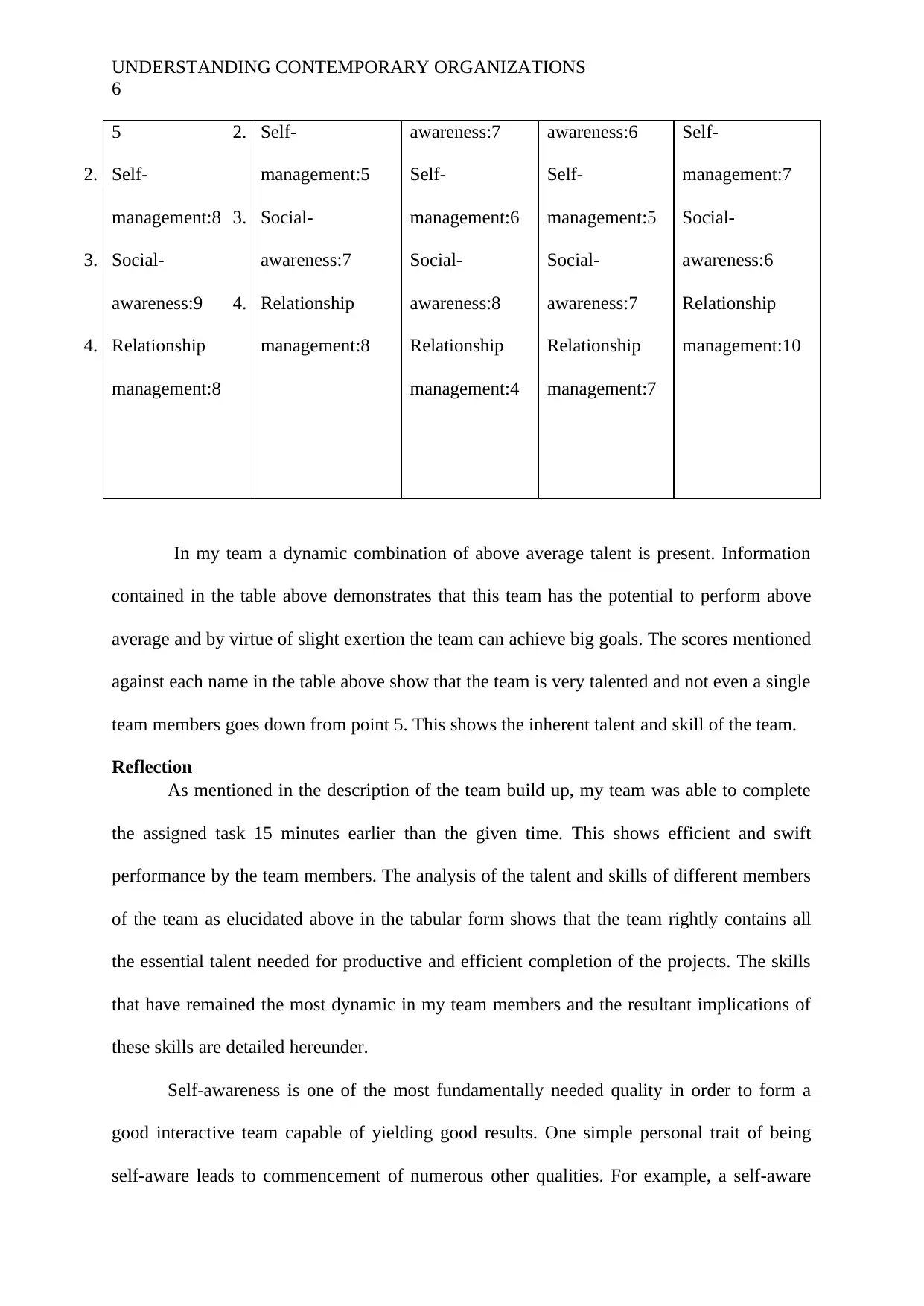
UNDERSTANDING CONTEMPORARY ORGANIZATIONS
6
5
2. Self-
management:8
3. Social-
awareness:9
4. Relationship
management:8
2. Self-
management:5
3. Social-
awareness:7
4. Relationship
management:8
awareness:7
Self-
management:6
Social-
awareness:8
Relationship
management:4
awareness:6
Self-
management:5
Social-
awareness:7
Relationship
management:7
Self-
management:7
Social-
awareness:6
Relationship
management:10
In my team a dynamic combination of above average talent is present. Information
contained in the table above demonstrates that this team has the potential to perform above
average and by virtue of slight exertion the team can achieve big goals. The scores mentioned
against each name in the table above show that the team is very talented and not even a single
team members goes down from point 5. This shows the inherent talent and skill of the team.
Reflection
As mentioned in the description of the team build up, my team was able to complete
the assigned task 15 minutes earlier than the given time. This shows efficient and swift
performance by the team members. The analysis of the talent and skills of different members
of the team as elucidated above in the tabular form shows that the team rightly contains all
the essential talent needed for productive and efficient completion of the projects. The skills
that have remained the most dynamic in my team members and the resultant implications of
these skills are detailed hereunder.
Self-awareness is one of the most fundamentally needed quality in order to form a
good interactive team capable of yielding good results. One simple personal trait of being
self-aware leads to commencement of numerous other qualities. For example, a self-aware
6
5
2. Self-
management:8
3. Social-
awareness:9
4. Relationship
management:8
2. Self-
management:5
3. Social-
awareness:7
4. Relationship
management:8
awareness:7
Self-
management:6
Social-
awareness:8
Relationship
management:4
awareness:6
Self-
management:5
Social-
awareness:7
Relationship
management:7
Self-
management:7
Social-
awareness:6
Relationship
management:10
In my team a dynamic combination of above average talent is present. Information
contained in the table above demonstrates that this team has the potential to perform above
average and by virtue of slight exertion the team can achieve big goals. The scores mentioned
against each name in the table above show that the team is very talented and not even a single
team members goes down from point 5. This shows the inherent talent and skill of the team.
Reflection
As mentioned in the description of the team build up, my team was able to complete
the assigned task 15 minutes earlier than the given time. This shows efficient and swift
performance by the team members. The analysis of the talent and skills of different members
of the team as elucidated above in the tabular form shows that the team rightly contains all
the essential talent needed for productive and efficient completion of the projects. The skills
that have remained the most dynamic in my team members and the resultant implications of
these skills are detailed hereunder.
Self-awareness is one of the most fundamentally needed quality in order to form a
good interactive team capable of yielding good results. One simple personal trait of being
self-aware leads to commencement of numerous other qualities. For example, a self-aware
⊘ This is a preview!⊘
Do you want full access?
Subscribe today to unlock all pages.

Trusted by 1+ million students worldwide

UNDERSTANDING CONTEMPORARY ORGANIZATIONS
7
person tends to be more confident, is an effective leader and has the potential to build a better
relationship. These specifications of self-awareness make this trait one of the most needed
quality in the modern world. As the currency of this personal quality is so high in the modern
world, therefore, it will not be a sheer exaggeration to say that the self-aware people are more
successful as compared to those who are not (Gibert, Tozer & Westboy, 2017).
The ability to build a stronger relationship as depicted by most of the members of the
team under consideration shows that building up great work relationships another most
needed trait in the modern world. This enables the team members to get more engaged in the
work and to perform from the whole heart and soul. The passion can be poured into the
profession only if the person is capable of building strong work relations (Guchait, Lei &
Tews, 2016). Developing strong work relations leads to the commencement of a number of
other opportunities and benefits at the workplace. These benefits include the spirit to
welcome the diversity at the workplace, development of mutual trust and respect and making
communication effective, engaging and more productive if all or any of these traits are
omitted out of the teamwork the productivity and efficiency of the team decline dramatically
(Ullah, Khattak & Rahman, 2018).
Recommendations
A number of innovative and unique approaches can be adopted by the team members
in order to ensure good results and mutual understanding. Some important ways that can be
adopted by the team members to make their experience of working in the team pleasant and
also enable them to learn as well.
Teamwork should be the priority. No individual should have the tendency to take
reigns of the command into one's hand and dissolve the team. Until and unless the
willingness of the team members to work in a team is present no significant milestone
be achieved. In this regard, the spirit of teamwork and mutual cooperation should be
7
person tends to be more confident, is an effective leader and has the potential to build a better
relationship. These specifications of self-awareness make this trait one of the most needed
quality in the modern world. As the currency of this personal quality is so high in the modern
world, therefore, it will not be a sheer exaggeration to say that the self-aware people are more
successful as compared to those who are not (Gibert, Tozer & Westboy, 2017).
The ability to build a stronger relationship as depicted by most of the members of the
team under consideration shows that building up great work relationships another most
needed trait in the modern world. This enables the team members to get more engaged in the
work and to perform from the whole heart and soul. The passion can be poured into the
profession only if the person is capable of building strong work relations (Guchait, Lei &
Tews, 2016). Developing strong work relations leads to the commencement of a number of
other opportunities and benefits at the workplace. These benefits include the spirit to
welcome the diversity at the workplace, development of mutual trust and respect and making
communication effective, engaging and more productive if all or any of these traits are
omitted out of the teamwork the productivity and efficiency of the team decline dramatically
(Ullah, Khattak & Rahman, 2018).
Recommendations
A number of innovative and unique approaches can be adopted by the team members
in order to ensure good results and mutual understanding. Some important ways that can be
adopted by the team members to make their experience of working in the team pleasant and
also enable them to learn as well.
Teamwork should be the priority. No individual should have the tendency to take
reigns of the command into one's hand and dissolve the team. Until and unless the
willingness of the team members to work in a team is present no significant milestone
be achieved. In this regard, the spirit of teamwork and mutual cooperation should be
Paraphrase This Document
Need a fresh take? Get an instant paraphrase of this document with our AI Paraphraser
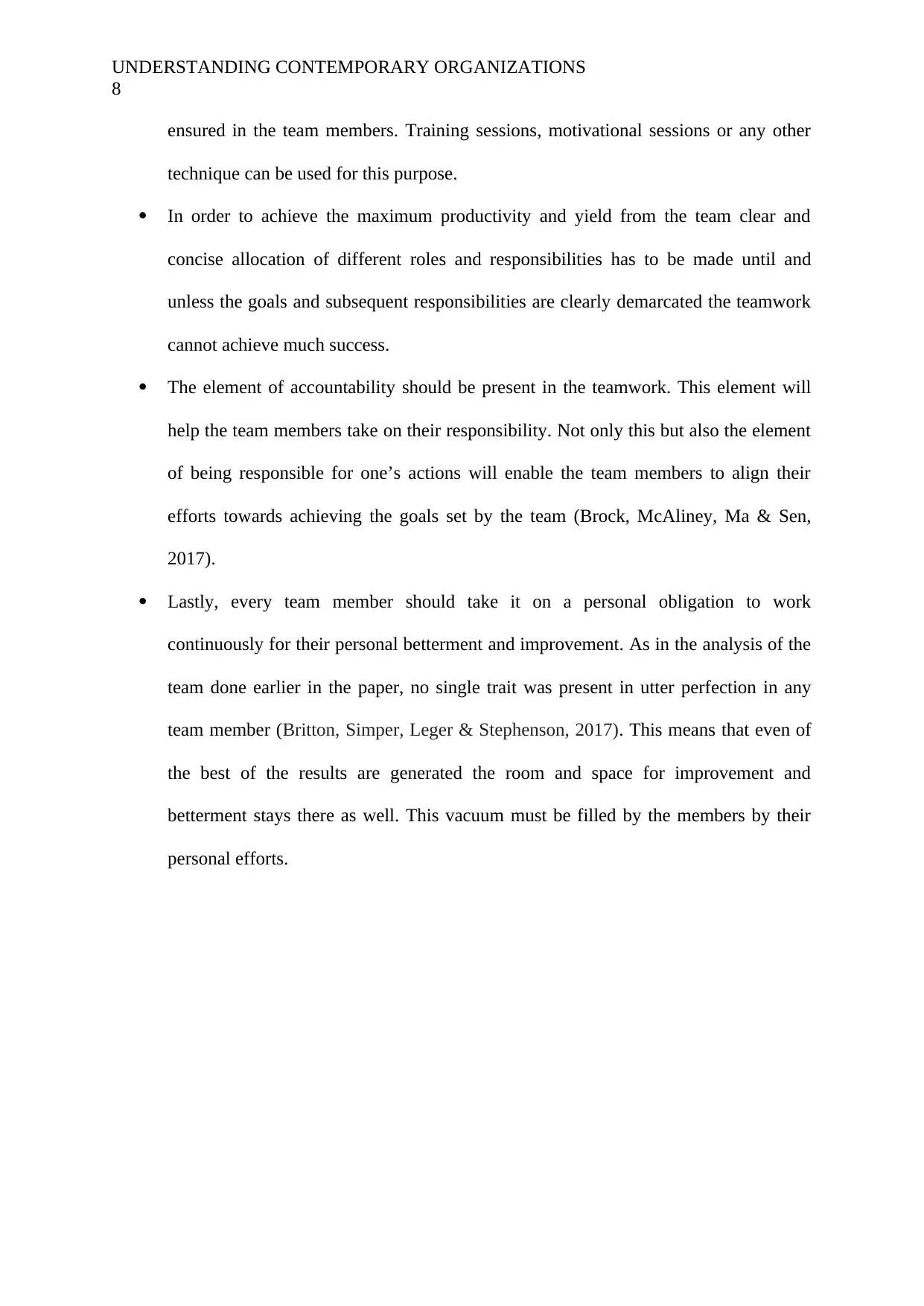
UNDERSTANDING CONTEMPORARY ORGANIZATIONS
8
ensured in the team members. Training sessions, motivational sessions or any other
technique can be used for this purpose.
In order to achieve the maximum productivity and yield from the team clear and
concise allocation of different roles and responsibilities has to be made until and
unless the goals and subsequent responsibilities are clearly demarcated the teamwork
cannot achieve much success.
The element of accountability should be present in the teamwork. This element will
help the team members take on their responsibility. Not only this but also the element
of being responsible for one’s actions will enable the team members to align their
efforts towards achieving the goals set by the team (Brock, McAliney, Ma & Sen,
2017).
Lastly, every team member should take it on a personal obligation to work
continuously for their personal betterment and improvement. As in the analysis of the
team done earlier in the paper, no single trait was present in utter perfection in any
team member (Britton, Simper, Leger & Stephenson, 2017). This means that even of
the best of the results are generated the room and space for improvement and
betterment stays there as well. This vacuum must be filled by the members by their
personal efforts.
8
ensured in the team members. Training sessions, motivational sessions or any other
technique can be used for this purpose.
In order to achieve the maximum productivity and yield from the team clear and
concise allocation of different roles and responsibilities has to be made until and
unless the goals and subsequent responsibilities are clearly demarcated the teamwork
cannot achieve much success.
The element of accountability should be present in the teamwork. This element will
help the team members take on their responsibility. Not only this but also the element
of being responsible for one’s actions will enable the team members to align their
efforts towards achieving the goals set by the team (Brock, McAliney, Ma & Sen,
2017).
Lastly, every team member should take it on a personal obligation to work
continuously for their personal betterment and improvement. As in the analysis of the
team done earlier in the paper, no single trait was present in utter perfection in any
team member (Britton, Simper, Leger & Stephenson, 2017). This means that even of
the best of the results are generated the room and space for improvement and
betterment stays there as well. This vacuum must be filled by the members by their
personal efforts.
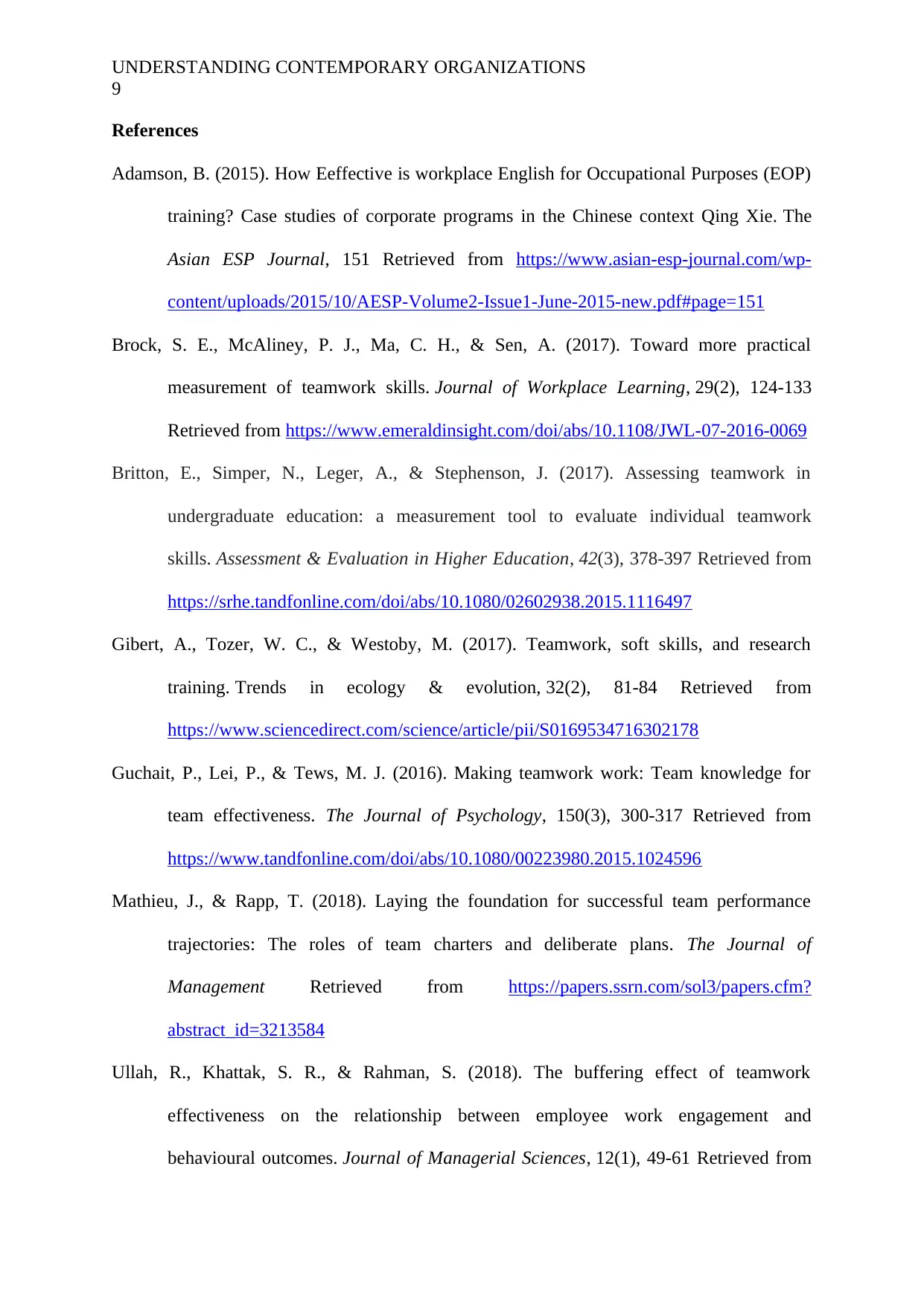
UNDERSTANDING CONTEMPORARY ORGANIZATIONS
9
References
Adamson, B. (2015). How Eeffective is workplace English for Occupational Purposes (EOP)
training? Case studies of corporate programs in the Chinese context Qing Xie. The
Asian ESP Journal, 151 Retrieved from https://www.asian-esp-journal.com/wp-
content/uploads/2015/10/AESP-Volume2-Issue1-June-2015-new.pdf#page=151
Brock, S. E., McAliney, P. J., Ma, C. H., & Sen, A. (2017). Toward more practical
measurement of teamwork skills. Journal of Workplace Learning, 29(2), 124-133
Retrieved from https://www.emeraldinsight.com/doi/abs/10.1108/JWL-07-2016-0069
Britton, E., Simper, N., Leger, A., & Stephenson, J. (2017). Assessing teamwork in
undergraduate education: a measurement tool to evaluate individual teamwork
skills. Assessment & Evaluation in Higher Education, 42(3), 378-397 Retrieved from
https://srhe.tandfonline.com/doi/abs/10.1080/02602938.2015.1116497
Gibert, A., Tozer, W. C., & Westoby, M. (2017). Teamwork, soft skills, and research
training. Trends in ecology & evolution, 32(2), 81-84 Retrieved from
https://www.sciencedirect.com/science/article/pii/S0169534716302178
Guchait, P., Lei, P., & Tews, M. J. (2016). Making teamwork work: Team knowledge for
team effectiveness. The Journal of Psychology, 150(3), 300-317 Retrieved from
https://www.tandfonline.com/doi/abs/10.1080/00223980.2015.1024596
Mathieu, J., & Rapp, T. (2018). Laying the foundation for successful team performance
trajectories: The roles of team charters and deliberate plans. The Journal of
Management Retrieved from https://papers.ssrn.com/sol3/papers.cfm?
abstract_id=3213584
Ullah, R., Khattak, S. R., & Rahman, S. (2018). The buffering effect of teamwork
effectiveness on the relationship between employee work engagement and
behavioural outcomes. Journal of Managerial Sciences, 12(1), 49-61 Retrieved from
9
References
Adamson, B. (2015). How Eeffective is workplace English for Occupational Purposes (EOP)
training? Case studies of corporate programs in the Chinese context Qing Xie. The
Asian ESP Journal, 151 Retrieved from https://www.asian-esp-journal.com/wp-
content/uploads/2015/10/AESP-Volume2-Issue1-June-2015-new.pdf#page=151
Brock, S. E., McAliney, P. J., Ma, C. H., & Sen, A. (2017). Toward more practical
measurement of teamwork skills. Journal of Workplace Learning, 29(2), 124-133
Retrieved from https://www.emeraldinsight.com/doi/abs/10.1108/JWL-07-2016-0069
Britton, E., Simper, N., Leger, A., & Stephenson, J. (2017). Assessing teamwork in
undergraduate education: a measurement tool to evaluate individual teamwork
skills. Assessment & Evaluation in Higher Education, 42(3), 378-397 Retrieved from
https://srhe.tandfonline.com/doi/abs/10.1080/02602938.2015.1116497
Gibert, A., Tozer, W. C., & Westoby, M. (2017). Teamwork, soft skills, and research
training. Trends in ecology & evolution, 32(2), 81-84 Retrieved from
https://www.sciencedirect.com/science/article/pii/S0169534716302178
Guchait, P., Lei, P., & Tews, M. J. (2016). Making teamwork work: Team knowledge for
team effectiveness. The Journal of Psychology, 150(3), 300-317 Retrieved from
https://www.tandfonline.com/doi/abs/10.1080/00223980.2015.1024596
Mathieu, J., & Rapp, T. (2018). Laying the foundation for successful team performance
trajectories: The roles of team charters and deliberate plans. The Journal of
Management Retrieved from https://papers.ssrn.com/sol3/papers.cfm?
abstract_id=3213584
Ullah, R., Khattak, S. R., & Rahman, S. (2018). The buffering effect of teamwork
effectiveness on the relationship between employee work engagement and
behavioural outcomes. Journal of Managerial Sciences, 12(1), 49-61 Retrieved from
⊘ This is a preview!⊘
Do you want full access?
Subscribe today to unlock all pages.

Trusted by 1+ million students worldwide
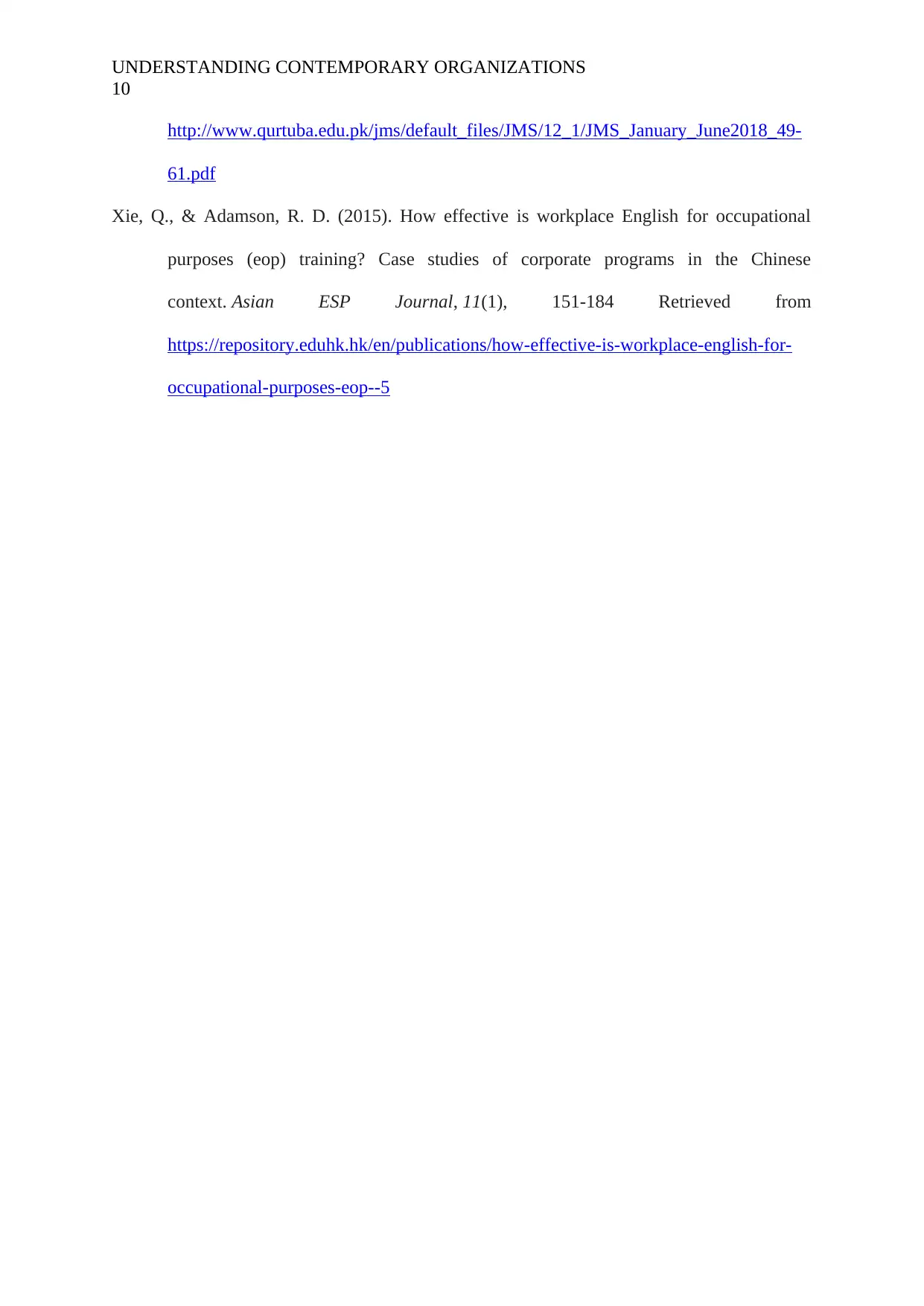
UNDERSTANDING CONTEMPORARY ORGANIZATIONS
10
http://www.qurtuba.edu.pk/jms/default_files/JMS/12_1/JMS_January_June2018_49-
61.pdf
Xie, Q., & Adamson, R. D. (2015). How effective is workplace English for occupational
purposes (eop) training? Case studies of corporate programs in the Chinese
context. Asian ESP Journal, 11(1), 151-184 Retrieved from
https://repository.eduhk.hk/en/publications/how-effective-is-workplace-english-for-
occupational-purposes-eop--5
10
http://www.qurtuba.edu.pk/jms/default_files/JMS/12_1/JMS_January_June2018_49-
61.pdf
Xie, Q., & Adamson, R. D. (2015). How effective is workplace English for occupational
purposes (eop) training? Case studies of corporate programs in the Chinese
context. Asian ESP Journal, 11(1), 151-184 Retrieved from
https://repository.eduhk.hk/en/publications/how-effective-is-workplace-english-for-
occupational-purposes-eop--5
1 out of 10
Related Documents
Your All-in-One AI-Powered Toolkit for Academic Success.
+13062052269
info@desklib.com
Available 24*7 on WhatsApp / Email
![[object Object]](/_next/static/media/star-bottom.7253800d.svg)
Unlock your academic potential
Copyright © 2020–2025 A2Z Services. All Rights Reserved. Developed and managed by ZUCOL.





